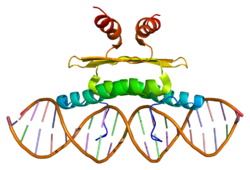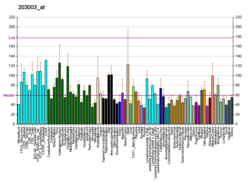Myocyte-specific enhancer factor 2D is a protein that in humans is encoded by the MEF2D gene.[5][6]
Interactions
[edit]MEF2D has been shown to interact with:
See also
[edit]References
[edit]- ^ a b c GRCh38: Ensembl release 89: ENSG00000116604 – Ensembl, May 2017
- ^ a b c GRCm38: Ensembl release 89: ENSMUSG00000001419 – Ensembl, May 2017
- ^ "Human PubMed Reference:". National Center for Biotechnology Information, U.S. National Library of Medicine.
- ^ "Mouse PubMed Reference:". National Center for Biotechnology Information, U.S. National Library of Medicine.
- ^ Breitbart RE, Liang CS, Smoot LB, Laheru DA, Mahdavi V, Nadal-Ginard B (Aug 1993). "A fourth human MEF2 transcription factor, hMEF2D, is an early marker of the myogenic lineage". Development. 118 (4): 1095–1106. doi:10.1242/dev.118.4.1095. PMID 8269842.
- ^ "Entrez Gene: MEF2D MADS box transcription enhancer factor 2, polypeptide D (myocyte enhancer factor 2D)".
- ^ a b Youn HD, Liu JO (Jul 2000). "Cabin1 represses MEF2-dependent Nur77 expression and T cell apoptosis by controlling association of histone deacetylases and acetylases with MEF2". Immunity. 13 (1): 85–94. doi:10.1016/s1074-7613(00)00010-8. PMID 10933397.
- ^ Youn HD, Sun L, Prywes R, Liu JO (Oct 1999). "Apoptosis of T cells mediated by Ca2+-induced release of the transcription factor MEF2". Science. 286 (5440): 790–793. doi:10.1126/science.286.5440.790. PMID 10531067.
- ^ Youn HD, Grozinger CM, Liu JO (Jul 2000). "Calcium regulates transcriptional repression of myocyte enhancer factor 2 by histone deacetylase 4". The Journal of Biological Chemistry. 275 (29): 22563–22567. doi:10.1074/jbc.C000304200. PMID 10825153.
- ^ Yang CC, Ornatsky OI, McDermott JC, Cruz TF, Prody CA (Oct 1998). "Interaction of myocyte enhancer factor 2 (MEF2) with a mitogen-activated protein kinase, ERK5/BMK1". Nucleic Acids Research. 26 (20): 4771–4777. doi:10.1093/nar/26.20.4771. PMC 147902. PMID 9753748.
- ^ Ornatsky OI, McDermott JC (Oct 1996). "MEF2 protein expression, DNA binding specificity and complex composition, and transcriptional activity in muscle and non-muscle cells". The Journal of Biological Chemistry. 271 (40): 24927–24933. doi:10.1074/jbc.271.40.24927. PMID 8798771.
- ^ Youn HD, Chatila TA, Liu JO (Aug 2000). "Integration of calcineurin and MEF2 signals by the coactivator p300 during T-cell apoptosis". The EMBO Journal. 19 (16): 4323–4331. doi:10.1093/emboj/19.16.4323. PMC 302027. PMID 10944115.
- ^ Park SY, Shin HM, Han TH (Sep 2002). "Synergistic interaction of MEF2D and Sp1 in activation of the CD14 promoter". Molecular Immunology. 39 (1–2): 25–30. doi:10.1016/s0161-5890(02)00055-x. PMID 12213324.
- ^ Choi SJ, Park SY, Han TH (Jul 2001). "14-3-3tau associates with and activates the MEF2D transcription factor during muscle cell differentiation". Nucleic Acids Research. 29 (13): 2836–2842. doi:10.1093/nar/29.13.2836. PMC 55772. PMID 11433030.
Further reading
[edit]- Hobson GM, Krahe R, Garcia E, Siciliano MJ, Funanage VL (Oct 1995). "Regional chromosomal assignments for four members of the MADS domain transcription enhancer factor 2 (MEF2) gene family to human chromosomes 15q26, 19p12, 5q14, and 1q12-q23". Genomics. 29 (3): 704–711. doi:10.1006/geno.1995.9007. PMID 8575763.
- Ornatsky OI, McDermott JC (Oct 1996). "MEF2 protein expression, DNA binding specificity and complex composition, and transcriptional activity in muscle and non-muscle cells". The Journal of Biological Chemistry. 271 (40): 24927–24933. doi:10.1074/jbc.271.40.24927. PMID 8798771.
- Yang CC, Ornatsky OI, McDermott JC, Cruz TF, Prody CA (Oct 1998). "Interaction of myocyte enhancer factor 2 (MEF2) with a mitogen-activated protein kinase, ERK5/BMK1". Nucleic Acids Research. 26 (20): 4771–4777. doi:10.1093/nar/26.20.4771. PMC 147902. PMID 9753748.
- Zhao M, New L, Kravchenko VV, Kato Y, Gram H, di Padova F, Olson EN, Ulevitch RJ, Han J (Jan 1999). "Regulation of the MEF2 family of transcription factors by p38". Molecular and Cellular Biology. 19 (1): 21–30. doi:10.1128/mcb.19.1.21. PMC 83862. PMID 9858528.
- Wang AH, Bertos NR, Vezmar M, Pelletier N, Crosato M, Heng HH, Th'ng J, Han J, Yang XJ (Nov 1999). "HDAC4, a human histone deacetylase related to yeast HDA1, is a transcriptional corepressor". Molecular and Cellular Biology. 19 (11): 7816–7827. doi:10.1128/mcb.19.11.7816. PMC 84849. PMID 10523670.
- Lu J, McKinsey TA, Nicol RL, Olson EN (Apr 2000). "Signal-dependent activation of the MEF2 transcription factor by dissociation from histone deacetylases". Proceedings of the National Academy of Sciences of the United States of America. 97 (8): 4070–4075. Bibcode:2000PNAS...97.4070L. doi:10.1073/pnas.080064097. PMC 18151. PMID 10737771.
- Kato Y, Zhao M, Morikawa A, Sugiyama T, Chakravortty D, Koide N, Yoshida T, Tapping RI, Yang Y, Yokochi T, Lee JD (Jun 2000). "Big mitogen-activated kinase regulates multiple members of the MEF2 protein family". The Journal of Biological Chemistry. 275 (24): 18534–18540. doi:10.1074/jbc.M001573200. PMID 10849446.
- Youn HD, Chatila TA, Liu JO (Aug 2000). "Integration of calcineurin and MEF2 signals by the coactivator p300 during T-cell apoptosis". The EMBO Journal. 19 (16): 4323–4331. doi:10.1093/emboj/19.16.4323. PMC 302027. PMID 10944115.
- Slepak TI, Webster KA, Zang J, Prentice H, O'Dowd A, Hicks MN, Bishopric NH (Mar 2001). "Control of cardiac-specific transcription by p300 through myocyte enhancer factor-2D". The Journal of Biological Chemistry. 276 (10): 7575–7585. doi:10.1074/jbc.M004625200. PMID 11096067.
- Choi SJ, Park SY, Han TH (Jul 2001). "14-3-3tau associates with and activates the MEF2D transcription factor during muscle cell differentiation". Nucleic Acids Research. 29 (13): 2836–2842. doi:10.1093/nar/29.13.2836. PMC 55772. PMID 11433030.
- Okamoto S, Li Z, Ju C, Scholzke MN, Mathews E, Cui J, Salvesen GS, Bossy-Wetzel E, Lipton SA (Mar 2002). "Dominant-interfering forms of MEF2 generated by caspase cleavage contribute to NMDA-induced neuronal apoptosis". Proceedings of the National Academy of Sciences of the United States of America. 99 (6): 3974–3979. Bibcode:2002PNAS...99.3974O. doi:10.1073/pnas.022036399. PMC 122633. PMID 11904443.
- Park SY, Shin HM, Han TH (Sep 2002). "Synergistic interaction of MEF2D and Sp1 in activation of the CD14 promoter". Molecular Immunology. 39 (1–2): 25–30. doi:10.1016/S0161-5890(02)00055-X. PMID 12213324.
- Linseman DA, Bartley CM, Le SS, Laessig TA, Bouchard RJ, Meintzer MK, Li M, Heidenreich KA (Oct 2003). "Inactivation of the Myocyte Enhancer Factor-2 Repressor Histone Deacetylase-5 by Endogenous Ca2 // Calmodulin-dependent Kinase II Promotes Depolarization-mediated Cerebellar Granule Neuron Survival". The Journal of Biological Chemistry. 278 (42): 41472–41481. doi:10.1074/jbc.M307245200. PMID 12896970.
- Beausoleil SA, Jedrychowski M, Schwartz D, Elias JE, Villén J, Li J, Cohn MA, Cantley LC, Gygi SP (Aug 2004). "Large-scale characterization of HeLa cell nuclear phosphoproteins". Proceedings of the National Academy of Sciences of the United States of America. 101 (33): 12130–12135. Bibcode:2004PNAS..10112130B. doi:10.1073/pnas.0404720101. PMC 514446. PMID 15302935.
- Grégoire S, Yang XJ (Mar 2005). "Association with class IIa histone deacetylases upregulates the sumoylation of MEF2 transcription factors". Molecular and Cellular Biology. 25 (6): 2273–2287. doi:10.1128/MCB.25.6.2273-2287.2005. PMC 1061617. PMID 15743823.
- Prima V, Gore L, Caires A, Boomer T, Yoshinari M, Imaizumi M, Varella-Garcia M, Hunger SP (May 2005). "Cloning and functional characterization of MEF2D/DAZAP1 and DAZAP1/MEF2D fusion proteins created by a variant t(1;19)(q23;p13.3) in acute lymphoblastic leukemia". Leukemia. 19 (5): 806–813. doi:10.1038/sj.leu.2403684. PMID 15744350.
External links
[edit]- MEF2D+protein,+human at the U.S. National Library of Medicine Medical Subject Headings (MeSH)








